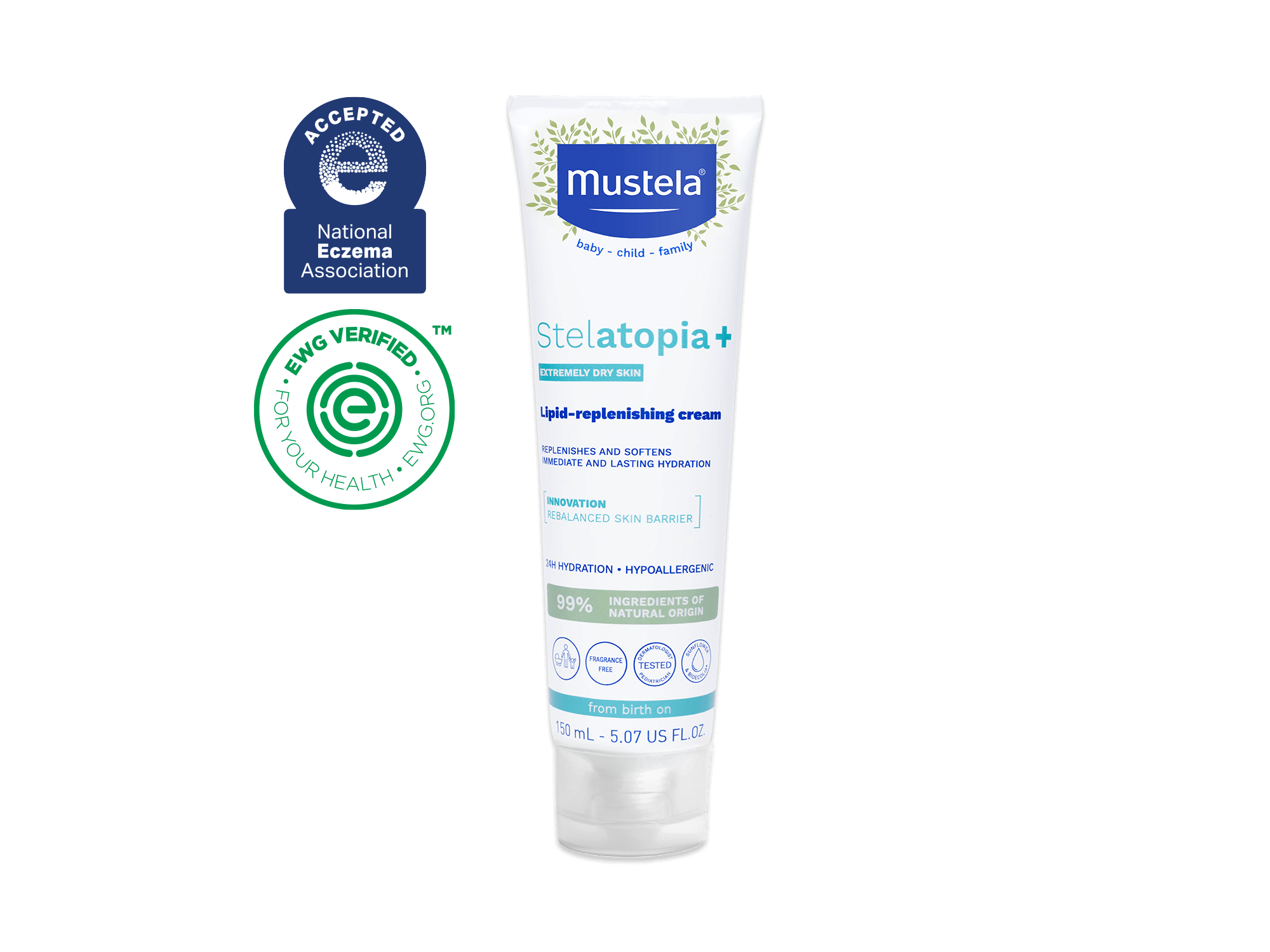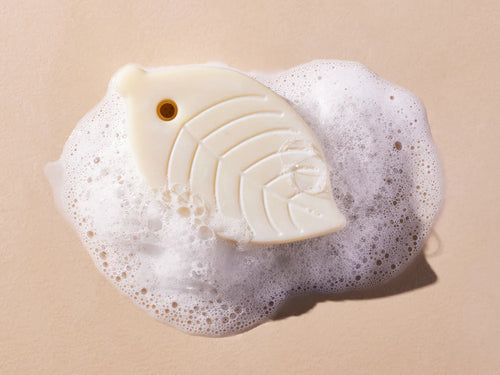With a brand-new baby in your arms, there are so many firsts that you and your newborn will experience together. One of them will be your baby’s first bath. This can be intimidating for many parents, but it doesn’t have to be!
Here, we’ll go over the two first baths that you’ll give your baby: their first sponge bath and their first tub bath. We’ll talk about the supplies you’ll need and how to get your little one squeaky clean while protecting their delicate skin.
Table Of Contents
Your Baby’s First Sponge Bath

Your baby’s first bath will be nothing more than a sponge bath, which is basically using a wet cloth to wipe them down.
But the first sponge bath won’t be right after your little one is born. Ideally, you should wait at least 24 hours after your baby enters the world before sponging them down.
There are a few reasons for this. First of all, tiny newborn babies get chilly easily! Waiting a day or two before their first sponge bath allows their body time to adjust to being in the world and lowers the risk of hypothermia.
Another important reason to wait is that the vernix (the coating on your newborn’s skin) has antibacterial properties and helps protect their skin. You don’t want to wash it off right away!
And, of course, whisking your baby off for a sponge bath within their first day cuts into those precious hours of mother-baby bonding and breastfeeding.
That said, when it comes time for your baby’s first sponge bath, here’s how to go about it.
How To Give Your Baby A Sponge Bath
1) Prepare The Area

Start by warming up the room where you will give your baby a sponge bath to help keep them from getting too cold.
Spread a towel on a flat surface. This is where you will place your baby. You’ll also need to gather a basin of warm water and a sponge or soft washcloth. Soap isn’t necessary for these first few baths!
2) Undress Your Baby
To get your baby ready, take off their clothes but keep them in their diaper. Then wrap your little one in a towel to keep them warm.
Lay your towel-wrapped baby on the flat surface you prepared. Remember to keep a hand on your little one at all times and take them with you if you have to leave the room. Safety first!
3) Wipe Down Your Baby
To wash your little one and keep them warm at the same time, only unwrap the area that you’re washing. Using the sponge or washcloth, start gently cleaning their skin, beginning with their head and working your way down.
You’ll simply wet the washcloth in the basin of water, wring out the extra water, and wipe or sponge your baby’s skin. Then repeat this process for their whole body!
Finish by taking your newborn’s diaper off and washing their diaper area. Keep in mind that you should wash baby girls from front to back.
And that’s it! Baby’s first sponge bath in the books. Now, let’s talk about what you’ll need to know for when and how to give your baby their first tub bath.
Your Baby’s First Tub Bath

With the thought of a wet, slippery baby in your hands, your baby’s first bath — their first real tub bath, that is — can be a bit more intimidating than sponge bathing.
First things first, when should you stop the sponging and start putting your baby in their cute, tiny tub?
When their umbilical cord falls off (typically around one or two weeks), your little one can be put in the water for a bath.
Just remember that bathing them too often can dry out their sweet, kissable skin. Three times a week will do the trick as long as you are thoroughly cleaning your baby’s bottom at every diaper change and cleansing their skin when drool and spit-up strike.
When the day for your baby’s first bath rolls around, here’s what should happen.
1) Prepare The Area

It’s important to prep for your baby’s bath and gather everything you need before undressing them and plopping them in the tub. Once your baby is in the bath, you’ll want to keep a hand on them at all times.
Start by turning the thermostat up a bit so your baby stays comfortable while they’re in the bath and in their birthday suit. Somewhere around 75 or 80 degrees Fahrenheit should do it.
Then, gather the bathtime supplies you’ll need. We recommend:
- A baby bathtub (or an insert for the sink)
- A soft towel to dry your baby
- A towel to put in the tub for your baby to lay on (optional)
- A soft washcloth to clean your baby
- Cleansing gel
- Baby shampoo
- A plastic cup
- Your baby’s clean clothes
- A clean diaper
- Diaper cream
2) Fill The Bath
Once you have gathered what you’ll need, fill the baby tub or sink with two to three inches of warm water. No more is needed! After all, your baby isn’t going swimming.
The temperature of the water should be around the same temperature as the human body, which is typically 98.6 degrees Fahrenheit.
If you’re using a bath thermometer, check that the temperature is somewhere between 90 and 100 degrees. If you don’t have a bath thermometer, you can test the water by simply dipping your wrist or elbow in it.
3) Wash Your Baby

After undressing your tiny one and double-checking the water temperature, lay them gently in the bath. Then wash their body by lathering them up with a safe and natural cleanser, like Mustela’s Gentle Cleansing Gel.
This gel will safely and effectively clean and soothe your baby's hair and skin while keeping their skin's natural oils intact!
For an organic option, try our Organic Cleansing Gel with Olive Oil and Aloe. Our formula comes in a recyclable bottle and is free of sulfates, parabens, phthalates, and phenoxyethanol, making it good for your baby and good for the planet!
After sudsing your little one up, rinse the soap off with water. This is where having a plastic cup comes in handy.
It’s a good idea to start by washing their face since the bathwater (the water you’ll rinse with) won’t be soapy at the beginning. Then keep working your way down their body, finishing with their private parts and bottom.
If you opt for baby shampoo in addition to cleanser, try Mustela’s Foam Shampoo for Newborns. Made with 99% ingredients of natural origin per ISO 16128 standard, this unique and ultra-gentle baby shampoo is specially formulated to cleanse your baby's hair and scalp while minimizing cradle cap flakes.
4) Dry Your Baby
After cleansing your baby’s skin and singing all the bathtime songs you want to sing, carefully lift your squeaky-clean little one from the tub and dry them off.
A wet baby can get cold quickly, so dry them and dress them sooner rather than later. As you towel-dry their skin, pat instead of rubbing.
This is especially important if your baby has eczema-prone skin since rubbing can irritate their skin even more. For more tips on how to bathe your baby to avoid eczema flare-ups, click here.
5) Apply Natural Baby Lotion

Your baby’s skin doesn’t need much to stay as soft and kissable as ever! However, a natural, safe, and non-irritating baby lotion can be just the thing.
Formulated with an elixir of plant-based ingredients including jojoba oil, sunflower oil, vitamins E and F, sweet almond oil, shea butter, and our signature avocado perseose, Mustela’s Hydra Bebe Lotion protects and strengthens your little one’s skin.
Or opt for an EWG Verified option, like Mustela’s Organic Hydrating Cream with Olive Oil and Aloe. This fragrance-free lotion is dermatologist- and pediatrician-tested and safe for even the most sensitive skin — from babies all the way to big kids and adults!
6) Diaper And Dress Your Baby
The only thing that’s left to do is to put a new diaper and clean clothes on your little one!
Protect their diaper area by applying Mustela’s Diaper Rash Cream 1 2 3 before diapering and dressing your baby in their pajamas or their clothes for the day.
Your Baby’s First Bath: Check!

Your baby’s first bath is just one of the exciting firsts that you’ll experience in this phase of parenthood. With tender loving care and the steps and tips we covered in this article, you’ll have a sweet, clean baby on your hands.
Whether you’re tackling the first sponge bath or the first tub bath, gather the supplies you’ll need — like Mustela’s Gentle Cleansing Gel and Organic Hydrating Cream with Olive Oil and Aloe — prepare the bath area, and carefully and gently cleanse your baby’s skin.
Although wet babies are slippery little things, you’ll be a baby bathtime pro in no time!
Frequently Asked Questions
1) When Should Newborns Get Their First Bath?
Although there is no strict rule, the World Health Organization recommends waiting at least 24 hours to give your newborn their first bath. Before this, you can use towels to gently wipe your little one off.
As mentioned above, their first bath should be a sponge bath. They won't be ready to be submerged in water until their umbilical cord stump falls off, usually within the first couple of weeks.
2) Why Should I Delay My Baby’s First Bath?
Historically, babies got their first bath within hours of their birth. However, new research has shown that it's better to wait.
There are a few reasons for this. For one, it gives your baby time to transition from the womb to the world. They must learn how to regulate their body temperature, and delaying a bath gives them a chance to do that.
In addition, waiting to bathe your baby gives you longer to focus on bonding and breastfeeding. This skin-to-skin contact plays a vital role in your baby's development, so you don't want to hinder that.
3) How Long After The Umbilical Cord Falls Off Should I Wait?
After waiting patiently for your newborn’s umbilical cord stump to dry up and fall off, you’re eager to put them in the tub for the first time. But it's important to ensure the belly button area is completely healed before you let them soak.
This process often takes a couple of days after the cord falls off. Once the area looks dry and healthy, you can go ahead with their first regular bath.
4) Should I Feed My Baby Before Or After A Bath?
Once your little one takes regular baths, there is no right timing. You can feed them before their bath or wait until afterward. Each has pros and cons, so you'll have to experiment and see which works best for you.
Feeding first calms your baby and ensures they aren't too hungry to enjoy their time in the tub. But, if they fall asleep while eating, you may need to wake them up for bath time.
Feeding after their bath helps get their body temperature back up quickly. It also provides comfort if they get upset in the tub.














